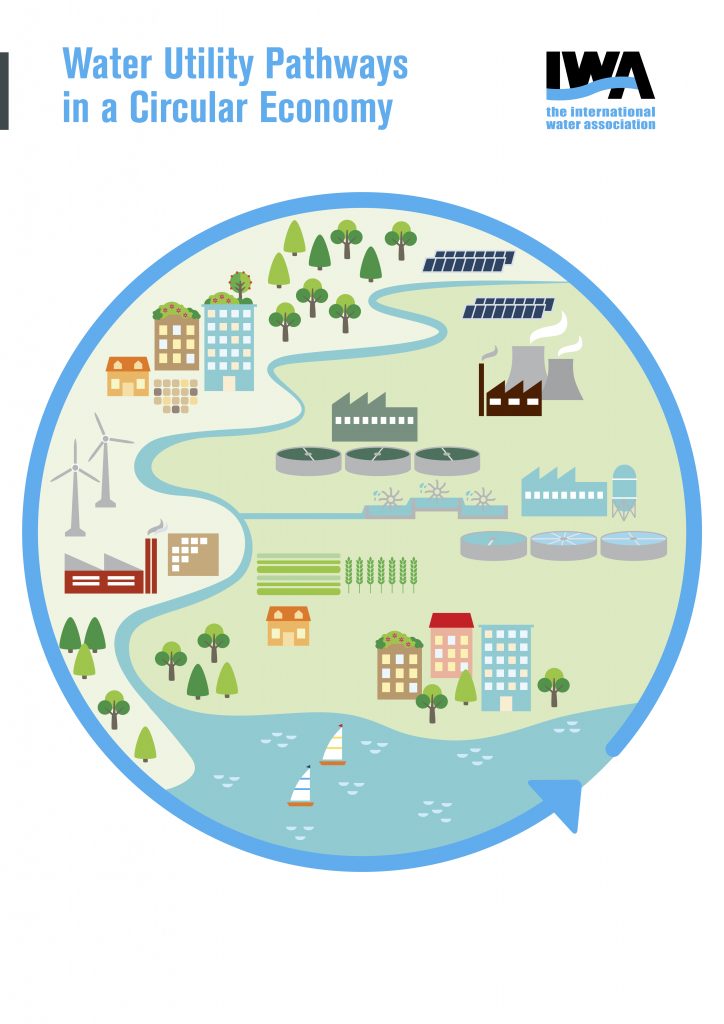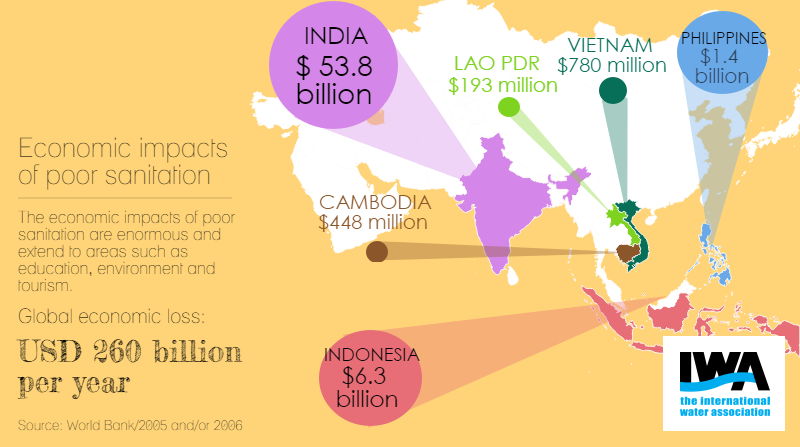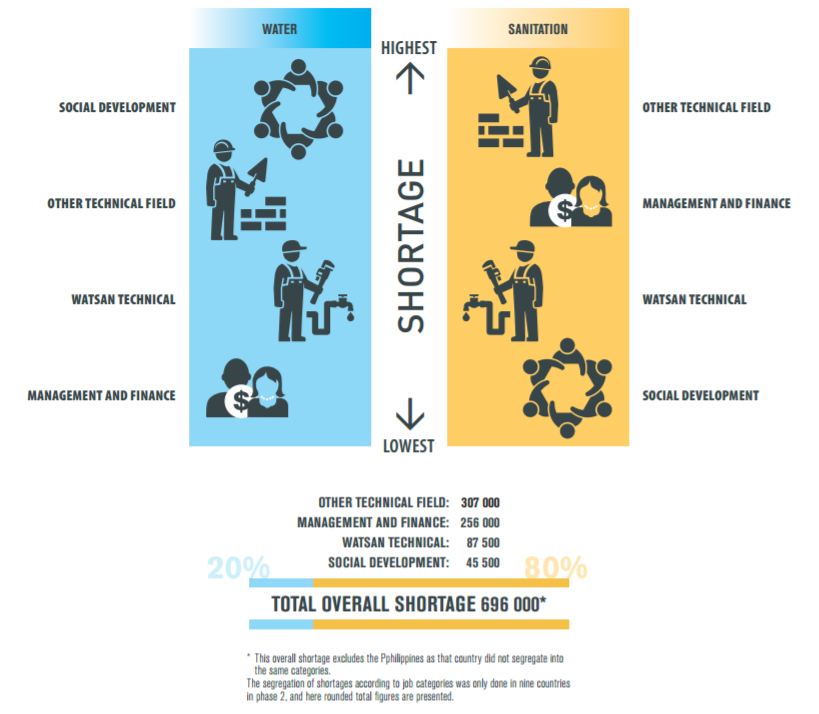The urban sanitation and wastewater challenge
Today, around 80% of all wastewater is discharged into the world’s waterways every day, where it creates health, environmental and climate-related hazards. Thus is a missed opportunity to recover water, energy, nutrients, and other precious materials embedded in wastewater. Simultaneously, 2.4 billion people are without sanitation facilities, including 946 million people who defecate in the open. Some 842,000 people in low- and middle-income countries die as a result of inadequate water, sanitation and hygiene each year.
Reducing, treating and reusing wastewater provides an alternative source of water in times of increasing water scarcity, and promotes human and ecosystem health. This supports Sustainable Development Goal 6.3 on improving water quality, and treating and reusing wastewater.
Achieving the Sustainable Development Goals
Wastewater management is complex, but transformational change is critical to achieve the Sustainable Development Goals of halving all untreated wastewater and providing universal access to adequate sanitation.
Decisive, urgent and large-scale action is needed to increase wastewater and fecal sludge treatment, reuse and recycling. Cities should be empowered to take the lead on a resource revolution, with governments and the private sector investing heavily in infrastructure to enable a transition to a circular economy. This will bring significant environmental, economic and social benefits. Infrastructure needs should include a portfolio of solutions that considers centralized and decentralized, natural and built, wet and dry options.
Wastewater treatment to mitigate climate change
The discharge of untreated effluent in water bodies does not only lead to eutrophication and human health risks, it also contributes significantly to GHG emissions in the form of nitrous oxide and methane. Emissions from untreated sewage represent three times the emissions of conventional wastewater treatments. The emissions from untreated sewage can represent a significant percentage of cities global emissions, when treatment coverage is still poor, as in many emerging cities.
A massive expansion of wastewater treatment, combined with appropriate technologies or concepts, is critical to put us on the path towards carbon neutrality.
The human resources challenge
The SDGs demand we halve the amount of untreated wastewater and provide universal access to adequate sanitation. During the same period the global population is estimated to rise to 8.5 billion people. Our task is to provide wastewater treatment to another 3.5 billion people by 2030.
A report published in 2014 looked at the human resource capacities in 15 developing countries to achieve universal access. The report highlighted that sanitation services face a huge capacity gap in human resources. The report specifically highlighted the following challenges across the countries assessed:
- Sanitation services are undermined by a poor supply of professionals when compared to water services
- Operation and maintenance of water and sanitation systems are chronically neglected, with human resources inadequately allocated
- There is insufficient money for recruiting and retaining staff for sanitation
- Qualified, skilled sanitation technicians are in short supply
- Inadequate access to appropriate tertiary education courses is a significant bottleneck
Our Human Right obligations
The adoption in 2010 of United Nations (UN) resolutions recognising the Human Right to Safe Drinking Water and Sanitation has opened new perspectives for the achievement of universal access to water and sanitation services. It has also created new opportunities and challenges for water and sanitation practitioners around the globe.
In 2016, IWA launched the Human Right to Water and Sanitation (HRWS) manual. The aim of this Manual is to promote informed decision-making by operators, managers and regulators, as well as to encourage them to engage actively in countries where the HRWS is being translated into national and local policy, legislation, and regulation. In most countries, creating an enabling environment is a first critical step in the process towards the realisation of the rights, followed by the allocation of roles and responsibilities to the various actors at national and local levels.
Reuse: the new Paradigm
Used water is one of the most under-exploited resources we have. Water from industrial or domestic use contains energy, water, organics, phosphates, nitrogen, cellulose, rare earths, and other resources. Technologies are increasingly making resource recovery from wastewater commercially feasible, including bio-gas, fertiliser, paper, metals, plastics and, perhaps most importantly, it is a source of ‘new’ water.
Resource recovery from wastewater strengthen the cyclical economy and can help make water utilities carbon and energy neutral. If you are curious about more, you can check out the work of the IWA Resource Recovery Cluster, including related publications, awards and events.
What is a utility of the future? from IWA on Vimeo.
The shift towards a Circular Economy
The concept of the circular economy, which aims to decouple economic growth and development from the consumption of finite resources, has emerged in response to the drawbacks of the conventional ‘take-make-consume and dispose’ model of growth. Water, with the energy it consumes and produces, and the materials it contains, has a critical role in transitioning to the circular economy.
For the water sector, transitioning to a circular economy presents an opportunity to accelerate and scale-up recent scientific and technological advances that support greater efficiency in the sector, and to fast track achieving the Sustainable Development Goals.
 |
 |
 |
 |
Cities: Unlocking the potential
Cities are emerging as the engines for the future economy. Whilst city development is an opportunity for economic growth, it is also a threat to liveability. As population is doubling at an increased rate, existing infrastructure is unable to keep up with growing demand from multiple users. Already many cities lack infrastructure for wastewater as a result of ageing, absent or inadequate wastewater management systems. As over one fifth of the global population is expected to be living in urban centres by 2030, there is greater need to manage wastewater wisely to not only reduce the threat to public and environmental health, but to build overall urban resilience.
Wastewater management in cities should not only focus on preventing further damage to the environment and safeguarding public health, but also a resource for alternate water and nutrient whose effective management is essential for the city’s water security. The newly developed Sustainable Development Goals (SDGs) provides a bold agenda and targets for more sustainable urban water and wastewater management to support safer, inclusive and more resilient cities. The IWA Principles for Water Wise Cities, which was launched in 2016, provides a framework to help cities leap frog to address this paradigm shift. The framework provides four levels of action (each enabled by the next level), accompanied by five building blocks through which the urban stakeholders can deliver sustainable urban water including wastewater management.
The main actors
Government
Develops laws to ensure water and wastewater throughout the entire water cycle does not compromise interests of the society as a whole, as well as environmental health. Ambitious laws and committing to international agreements is key to moving forward. A main challenge is often that the area of sanitation and wastewater does not have a clear lead as the responsibility is divided between different ministries and departments – for example health and environment. Collaboration between these parties together with a clear lead is essential to achieve success.
Cities and Local Authorities
Political commitment and prioritization of sanitation from cities and local authorities is important for ensuring local progress and efficient implementation. Of importance is to acknowledge that sanitation needs to be part of urban planning, and the co-benefits from integrated solutions. An example of growing importance is nature based solutions, that not only can treat or stores wastewater but also have recreation value, raise awareness, and allow for resource recovery on a local level (as replenishing urban water bodies or be used for irrigation for urban farming).
Regulators
Enforcing regulations and ensuring on a more detailed level, to assure an ambitious agenda is followed. Again, collaborations across departments is crucial as well as a clear lead when it comes to responsibility, to ensure sanitation coverage is increased in an equitable manner and that circular economy solutions are promoted and encouraged. Clear guidelines and standards on emissions and water quality for reuse is an important incentive.
Utilities
Engage on a day to day basis with citizens for complaints, leakages, etc. and lead actor to increase coverage and safeguarding the more vulnerable in the society are taken into account, for example urban poor in informal settlements. Utilities are required to follow regulations but examples also exist where utilities have been moving forward with innovative approaches (for example for resource recovery and reuse) and legislation have followed afterwards. Close partnerships with city leaders is important to ensure integrated approaches, as well as that possible decentralised systems are included in the overall planning, operation and management.
Industry
As large water users, water polluters and potential customers for materials – industry is a key actor for wastewater, especially for moving towards resource recovery and a circular economy. A growing awareness of environmental risk means industry leaders are increasingly looking for ways to reduce their water footprint and minimise environmental degradation. Water cascading between industries is an excellent way to collaborate on wastewater and to move towards a circular economy while cutting costs, as the wastewater from one industry with no or little treatment can be fit for purpose for another industry.
Water Resource Managers
Integrated planning for all users and taking into account that all water has a quality that is fit for purpose. Agriculture will often be the largest user of water, but potable water quality is in many cases not required and recycled water is generally an important piece to manage water wisely within a basin.
Call to Action
IWA has embarked on a journey to translate the SDGs into water professionals day-to-day work. To better understand the overarching goals, we want to tell the stories on how our members are already making the way, and show examples to inspire others to contribute to the global effort of achieving the SDGs. We kick off in 2017 with the same theme as the UN World Water Day: Wastewater, and specifically SDG 6.3 on wastewater treatment, reuse and recycling.
From World Water Day up until Stockholm Water Week, where IWA is a Key Collaborating Partner with SIWI – we will be collecting case stories, SDG Spotlights and based on the spotlights a list of action items to achive SDG 6.3 will be made. What we intend this critical reflection to lead to, through a ‘Call to Action’ to IWA members and partners, is an agenda for change that gives priority to transformational actions so that by 2030, we have positive health and environmental outcomes as a result of improved management of urban sanitation and wastewater. And within this, the roles and responsibilities of key stakeholders, in terms of ownership and accountability, is clearly expressed.
You can see the SDG Spotlights below, and get in touch for more information or to submit your very own story to Marie R. Sagen.




